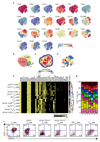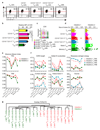Memory CD4+ T cells are generated in the human fetal intestine
- PMID: 30664737
- PMCID: PMC6420108
- DOI: 10.1038/s41590-018-0294-9
Memory CD4+ T cells are generated in the human fetal intestine
Abstract
The fetus is thought to be protected from exposure to foreign antigens, yet CD45RO+ T cells reside in the fetal intestine. Here we combined functional assays with mass cytometry, single-cell RNA sequencing and high-throughput T cell antigen receptor (TCR) sequencing to characterize the CD4+ T cell compartment in the human fetal intestine. We identified 22 CD4+ T cell clusters, including naive-like, regulatory-like and memory-like subpopulations, which were confirmed and further characterized at the transcriptional level. Memory-like CD4+ T cells had high expression of Ki-67, indicative of cell division, and CD5, a surrogate marker of TCR avidity, and produced the cytokines IFN-γ and IL-2. Pathway analysis revealed a differentiation trajectory associated with cellular activation and proinflammatory effector functions, and TCR repertoire analysis indicated clonal expansions, distinct repertoire characteristics and interconnections between subpopulations of memory-like CD4+ T cells. Imaging mass cytometry indicated that memory-like CD4+ T cells colocalized with antigen-presenting cells. Collectively, these results provide evidence for the generation of memory-like CD4+ T cells in the human fetal intestine that is consistent with exposure to foreign antigens.
Conflict of interest statement
The authors declare no competing financial interests.
Figures







Comment in
-
Pre-birth memory.Nat Immunol. 2019 Mar;20(3):254-256. doi: 10.1038/s41590-019-0326-0. Nat Immunol. 2019. PMID: 30742077 No abstract available.
References
-
- Janeway CA., Jr Approaching the asymptote? Evolution and revolution in immunology. Cold Spring Harb Symp Quant Biol. 1989;54(Pt 1):1–13. - PubMed
-
- Bunders MJ, et al. Memory CD4(+)CCR5(+) T cells are abundantly present in the gut of newborn infants to facilitate mother-to-child transmission of HIV-1. Blood. 2012;120:4383–4390. - PubMed
-
- Zhang X, et al. CD4 T cells with effector memory phenotype and function develop in the sterile environment of the fetus. Sci Transl Med. 2014;6:238ra72. - PubMed
Publication types
MeSH terms
Substances
Grants and funding
LinkOut - more resources
Full Text Sources
Other Literature Sources
Molecular Biology Databases
Research Materials

